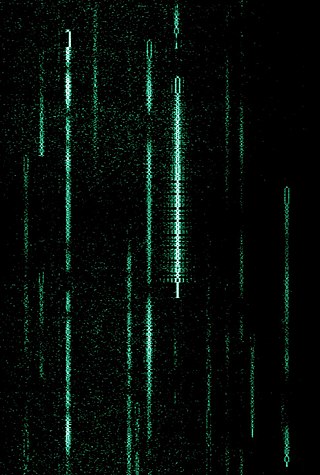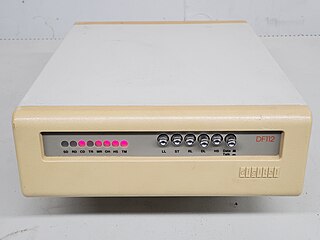In electronics and telecommunications, modulation is the process of varying one or more properties of a periodic waveform, called the carrier signal, with a separate signal called the modulation signal that typically contains information to be transmitted. For example, the modulation signal might be an audio signal representing sound from a microphone, a video signal representing moving images from a video camera, or a digital signal representing a sequence of binary digits, a bitstream from a computer.

In digital radio, packet radio is the application of packet switching techniques to digital radio communications. Packet radio uses a packet switching protocol as opposed to circuit switching or message switching protocols to transmit digital data via a radio communication link.

Radioteletype (RTTY) is a telecommunications system consisting originally of two or more electromechanical teleprinters in different locations connected by radio rather than a wired link. Radioteletype evolved from earlier landline teleprinter operations that began in the mid-1800s. The US Navy Department successfully tested printing telegraphy between an airplane and ground radio station in 1922. Later that year, the Radio Corporation of America successfully tested printing telegraphy via their Chatham, Massachusetts, radio station to the RMS Majestic. Commercial RTTY systems were in active service between San Francisco and Honolulu as early as April 1932 and between San Francisco and New York City by 1934. The US military used radioteletype in the 1930s and expanded this usage during World War II. From the 1980s, teleprinters were replaced by personal computers (PCs) running software to emulate teleprinters.

In telecommunications, an acoustic coupler is an interface device for coupling electrical signals by acoustical means—usually into and out of a telephone.

Frequency-shift keying (FSK) is a frequency modulation scheme in which digital information is encoded on a carrier signal by periodically shifting the frequency of the carrier between several discrete frequencies. The technology is used for communication systems such as telemetry, weather balloon radiosondes, caller ID, garage door openers, and low frequency radio transmission in the VLF and ELF bands. The simplest FSK is binary FSK, in which the carrier is shifted between two discrete frequencies to transmit binary information.

A radiotelephone, abbreviated RT, is a radio communication system for conducting a conversation; radiotelephony means telephony by radio. It is in contrast to radiotelegraphy, which is radio transmission of telegrams (messages), or television, transmission of moving pictures and sound. The term is related to radio broadcasting, which transmit audio one way to listeners. Radiotelephony refers specifically to two-way radio systems for bidirectional person-to-person voice communication between separated users, such as CB radio or marine radio. In spite of the name, radiotelephony systems are not necessarily connected to or have anything to do with the telephone network, and in some radio services, including GMRS, interconnection is prohibited.
A subcarrier is a sideband of a radio frequency carrier wave, which is modulated to send additional information. Examples include the provision of colour in a black and white television system or the provision of stereo in a monophonic radio broadcast. There is no physical difference between a carrier and a subcarrier; the "sub" implies that it has been derived from a carrier, which has been amplitude modulated by a steady signal and has a constant frequency relation to it.

PSK31 or "Phase Shift Keying, 31 Baud", also BPSK31 and QPSK31, is a popular computer-sound card-generated radioteletype mode, used primarily by amateur radio operators to conduct real-time keyboard-to-keyboard chat, most often using frequencies in the high frequency amateur radio bands (near-shortwave). PSK31 is distinguished from other digital modes in that it is specifically tuned to have a data rate close to typing speed, and has an extremely narrow bandwidth, allowing many conversations in the same bandwidth as a single voice channel. This narrow bandwidth makes better use of the RF energy in a very narrow space thus allowing relatively low-power equipment to communicate globally using the same skywave propagation used by shortwave radio stations.
AX.25 is a data link layer protocol originally derived from layer 2 of the X.25 protocol suite and designed for use by amateur radio operators. It is used extensively on amateur packet radio networks.
The V.23 standard was an early modem standard first approved by ITU-T precursor CCITT in 1964.

The Bell 202 modem was an early (1976) modem standard developed by the Bell System. It specifies audio frequency-shift keying (AFSK) to encode and transfer data at a rate of 1200 bits per second (bit/s), half-duplex. It has separate sets of circuits for 1200 bit/s and 300 bit/s rates. These signalling protocols, also used in third-party modems, are referred to generically as Bell 202 modulation, and any device employing it as Bell-202-compatible.
Olivia MFSK is an amateur radioteletype protocol, using multiple frequency-shift keying (MFSK) and designed to work in difficult conditions on shortwave bands. The signal can be accurately received even if the surrounding noise is 10 dB stronger. It is commonly used by amateur radio operators to reliably transmit ASCII characters over noisy channels using the high frequency (3–30 MHz) spectrum. The effective data rate of the Olivia MFSK protocol is 150 characters/minute.
In a digitally modulated signal or a line code, symbol rate, modulation rate or baud rate is the number of symbol changes, waveform changes, or signaling events across the transmission medium per unit of time. The symbol rate is measured in baud (Bd) or symbols per second. In the case of a line code, the symbol rate is the pulse rate in pulses per second. Each symbol can represent or convey one or several bits of data. The symbol rate is related to the gross bit rate, expressed in bits per second.
In a conventional, analog two-way radio system, a standard radio has noise squelch or carrier squelch, which allows a radio to receive all transmissions. Selective calling is used to address a subset of all two-way radios on a single radio frequency channel. Where more than one user is on the same channel, selective calling can address a subset of all receivers or can direct a call to a single radio. Selective calling features fit into two major categories—individual calling and group calling. Individual calls generally have longer time-constants: it takes more air-time to call an individual radio unit than to call a large group of radios.
WSJT-X is a computer program used for weak-signal radio communication between amateur radio operators. The program was initially written by Joe Taylor, K1JT, but is now open source and is developed by a small team. The digital signal processing techniques in WSJT-X make it substantially easier for amateur radio operators to employ esoteric propagation modes, such as high-speed meteor scatter and moonbounce. Additionally WSJT is able to send signal reports to spotting networks such as PSK Reporter.

A modulator-demodulator, commonly referred to as a modem, is a computer hardware device that converts data from a digital format into a format suitable for an analog transmission medium such as telephone or radio. A modem transmits data by modulating one or more carrier wave signals to encode digital information, while the receiver demodulates the signal to recreate the original digital information. The goal is to produce a signal that can be transmitted easily and decoded reliably. Modems can be used with almost any means of transmitting analog signals, from LEDs to radio.

The Bell 101 modem, or Bell 101 Data Set, was the first commercial modem for computers, released by AT&T Corporation in 1958 for use by SAGE, and made commercially available in 1959, shortly after AT&T's Bell Labs announced their 110 baud modulation frequencies. The Bell 101 allowed digital data to be transmitted over regular unconditioned telephone lines at a speed of 110 bits per second.

Fldigi is a free and open-source program which allows an ordinary computer's sound card to be used as a simple two-way data modem. The software is mostly used by amateur radio operators who connect the microphone and headphone connections of an amateur radio SSB or FM transceiver to the computer's headphone and microphone connections, respectively.











